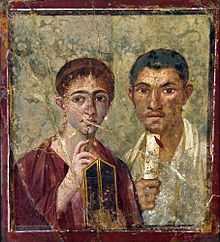House of Julia Felix
Coordinates: 40°45′6.74″N 14°29′35.84″E / 40.7518722°N 14.4932889°E

Julia Felix, Felix a Roman cognomen meaning "The Fortunate One" was an epithet of the dictator L. Cornelius Sulla and his descendants in the Republican period.[1] In the Imperial period it was a name involving luck as well as one of the most common cognomina and slave names.[1]
Background
Julia Felix was a Roman woman who resided in the city of Pompeii. Julia Felix was a very wealthy property owner who inherited her money from her family. She owned a grand villa that took up an entire block in the city of Pompeii and it is documented by researchers as being well furnished and decorated until it was damaged in the major earthquake of 62 AD. After the earthquake Julia rented out her property to residents of Pompeii who may have lost their homes and transformed parts of her villa into public baths, shops, taverns, and apartments. Renting out her villa helped her earn extra income and establish herself as a property owner, business woman, and public figure in Pompeii.[2]
Architecture
The homes of the wealthy in Pompeii were built around courtyards that were rectangular in shape into which the main rooms opened. These homes had enclosed gardens and private water supply.[3] Through the tufa period in Roman history, Pompeians used relief stucco work to add something extra to the architecture, marble dust for luminosity, and used paints with rich colors.[4]

Inside the villa
Inside their villas, Pompeians chose many different ways to express themselves. Some Pompeians would copy Greek paintings and others would choose a theme of love or fertility, but most chose landscapes. Those found in Pompeii were of local scenes, villas from along the coast, or woodland and hills. When one owner in Pompeii lost part of his garden to a new room, he created the lost garden on the walls of the room.[3]
The art inside the villa of Julia Felix is also very interesting. Her villa contains a unique series of paintings depicting daily life in the Pompeian Forum, including market stalls, an open-air school, conversation, and a beggar receiving alms from a lady with her maid. Julia Felix was descendant of the Julii, who were Imperial freedmen, which could have influenced her choice in artwork of the middle-class life.[5]
Excavation
Since the excavations of Pompeii, much has been revealed about the villa of Julia Felix. In as early as 1755 many sections belonging to the villa began to be uncovered when the city of Pompeii was excavated. A complex tabernae (tavern), luxurious baths, and richly decorated formal garden dining rooms were revealed in the first excavation. Between the years 1912-1935 an unknown shrine and the façade along the Via dell’Abbondanza of the building was uncovered,[6] but when the entire building was excavated, two Roman statues were found as well.[7]
Between the years 1998-1999 some of the most important discoveries were made by excavators. A trench found behind the caldarium dated back as early as the Augustan period. The caldarium revealed a drain that conducted water from the hypocaust floor, that conducted heat for a bath or room in a Roman home. A nymphaeum or grotto of nymphs with a waterstair fountain and triclinium was also discovered which was a modification put in after the earthquake of 62 A.D.[8]
References
- ↑ 1.0 1.1 Brill’s New Pauly: Encyclopedia of the Ancient World, Volume 5, Brill Academic Publishers, 2004.
- ↑ Fowler, Robin (2006-05-01). "Independent Women of Pompeii". authorsden.com. Retrieved 2007-05-08.
- ↑ 3.0 3.1 Drummond, Andrew (1993). The World of the Romans. New York: Oxford University Press. p. 132.
- ↑ "Pompeii". The Princeton Encyclopedia of Classical Sites. Princeton University Press. 1976.
- ↑ Silberberg-Peirce, Susan (1993). "The Muse Restored: Images of Women in Roman Painting". Woman's Art Journal 14 (2): 28–36 [p. 29]. doi:10.2307/1358447.
- ↑ Parslow, Christopher Charles (1988). "The 89th General Meeting of the Archaeological Institute of America". American Journal of Archaeology 92 (2): 229–284 [p. 281]. doi:10.2307/505632.
- ↑ Parslow, Christopher Charles (1989). "The 90th General Meeting of the Archaeological Institute of America". American Journal of Archaeology 93 (2): 243–284 [p. 278]. doi:10.2307/505093.
- ↑ Parslow, Christopher (2001). "The 102nd Annual Meeting of the Archaeological Institute of America". American Journal of Archaeology 105 (2): 245–311 [p. 261]. doi:10.2307/507273.
| ||||||||||||||||||||||||||||||||||||||